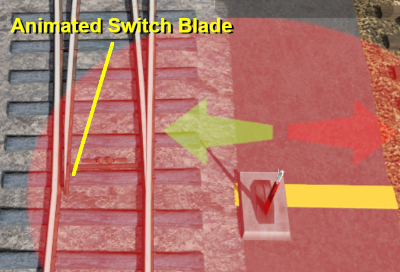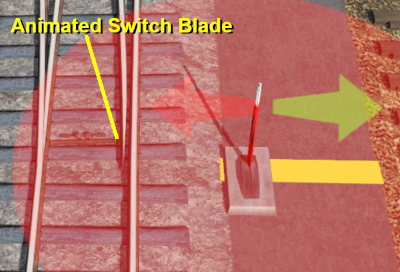How to Use Procedural Track
m (→What is Procedural Track?) |
m |
||
| Line 13: | Line 13: | ||
='''What is Procedural Track?'''= | ='''What is Procedural Track?'''= | ||
| − | <table cellpadding= | + | <table cellpadding=4 bgcolor=#c1e7e7> |
<tr valign="top"> | <tr valign="top"> | ||
<td>[[image:DotPoint.JPG|link=]]</td> | <td>[[image:DotPoint.JPG|link=]]</td> | ||
| Line 78: | Line 78: | ||
</tr> | </tr> | ||
</table> | </table> | ||
| + | <br> | ||
<table> <!-- BEGIN Nav Buttons Table --> | <table> <!-- BEGIN Nav Buttons Table --> | ||
<tr valign="top"> | <tr valign="top"> | ||
| Line 96: | Line 97: | ||
='''Laying Procedural Track'''= | ='''Laying Procedural Track'''= | ||
| − | <table cellpadding= | + | <table cellpadding=4 bgcolor=#c1e7e7> |
<tr valign="top"> | <tr valign="top"> | ||
<td>[[file:DotPoint.JPG|link=]]</td> | <td>[[file:DotPoint.JPG|link=]]</td> | ||
| Line 107: | Line 108: | ||
<span style="background-color: #ffffb0; font-weight: 700;"> Faulty (incorrectly formed) procedural track junctions will work perfectly well as ''non-procedural'' junctions </span> - they can be switched left and right, and trains will pass over them correctly. But the special features that they have will not appear. | <span style="background-color: #ffffb0; font-weight: 700;"> Faulty (incorrectly formed) procedural track junctions will work perfectly well as ''non-procedural'' junctions </span> - they can be switched left and right, and trains will pass over them correctly. But the special features that they have will not appear. | ||
| − | <table cellpadding= | + | <table cellpadding=4 bgcolor=#c1e7e7> |
<tr valign="top"> | <tr valign="top"> | ||
<td>[[file:DotPoint.JPG|link=]]</td> | <td>[[file:DotPoint.JPG|link=]]</td> | ||
| − | <td>A '''red track spline circle''' indicates that the procedural track junction is faulty</td> | + | <td>A '''red track spline circle''' in '''Surveyor Classic''' indicates that the procedural track junction is faulty</td> |
</tr> | </tr> | ||
</table> | </table> | ||
| − | + | <br> | |
<table> | <table> | ||
<tr valign="top"> | <tr valign="top"> | ||
| Line 124: | Line 125: | ||
</tr> | </tr> | ||
</table> | </table> | ||
| + | <br> | ||
| + | <table cellpadding=4 bgcolor=#c1e7e7> | ||
| + | <tr valign="top"> | ||
| + | <td>[[file:DotPoint.JPG|link=]]</td> | ||
| + | <td>A '''red track spline "dot"''' in '''Surveyor 2.0''' indicates that the procedural track junction is faulty</td> | ||
| + | </tr> | ||
| + | </table> | ||
| + | <br> | ||
| + | <table width=650> | ||
| + | <tr valign="top"> | ||
| + | <td width=300>[[image:Procedural-S20-Normal.png|link=]]<br> | ||
| + | A normal procedural track junction in '''Surveyor 2.0''' is shown as a '''black''' track spline point</td> | ||
| + | <td width=50> </td> | ||
| + | <td width=300>[[image:Procedural-S20-NotNormal.png|link=]]<br> | ||
| + | A faulty procedural track junction in '''Surveyor 2.0''' is shown as a <span style="color: red; font-weight: 700;">red</span> track spline point. A better indicator is the absence of the moveable switch blade and the check rails/frogs.</td> | ||
| + | </tr> | ||
| + | </table> | ||
| + | <br> | ||
| + | |||
<table> <!-- BEGIN Nav Buttons Table --> | <table> <!-- BEGIN Nav Buttons Table --> | ||
<tr valign="top"> | <tr valign="top"> | ||
| Line 175: | Line 195: | ||
*adjust the spline heights to create a level junction | *adjust the spline heights to create a level junction | ||
<br> | <br> | ||
| − | <table bgcolor= | + | <table bgcolor=#000000 width=450> |
<tr valign="top"> | <tr valign="top"> | ||
<td> | <td> | ||
| Line 202: | Line 222: | ||
*adjust the placement of the second junction to allow the frogs/check rails to be added to the first junction | *adjust the placement of the second junction to allow the frogs/check rails to be added to the first junction | ||
<br> | <br> | ||
| − | <table bgcolor= | + | <table bgcolor=#000000 width=450> |
<tr valign="top"> | <tr valign="top"> | ||
<td> | <td> | ||
| Line 231: | Line 251: | ||
='''Trainz Wiki'''= | ='''Trainz Wiki'''= | ||
| − | <table cellpadding= | + | <table cellpadding=4 bgcolor=#ffffff> |
<tr valign="top"> | <tr valign="top"> | ||
<td>[[file:TrainzWiki.png|link=]]</td> | <td>[[file:TrainzWiki.png|link=]]</td> | ||
Revision as of 11:46, 13 March 2022
The information in this Wiki Page applies to TANE, TRS19 and Trainz Plus. This guide covers the use of procedural track in Trainz Surveyor, not how to create procedural track assets - see Trainz Wiki Links at the bottom of this page.
Contents |
What is Procedural Track?
| Procedural tracks provide animated switch points plus check rails and frogs at track junctions |
Procedural track works just like the standard or non-procedural track that was the only type available before T:ANE. However, it provides additional cosmetic features (animated blades, frogs and check rails) to junctions. These features are built into the track asset and do not have to be manually added when laying track.
| Procedural Track
|
Non Procedural Track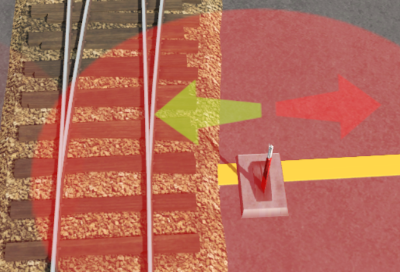 |
|
|||||||||||
Procedural Track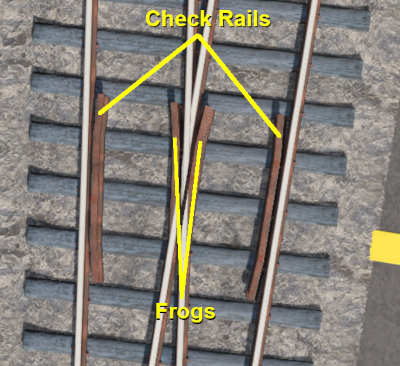 |
Non Procedural Track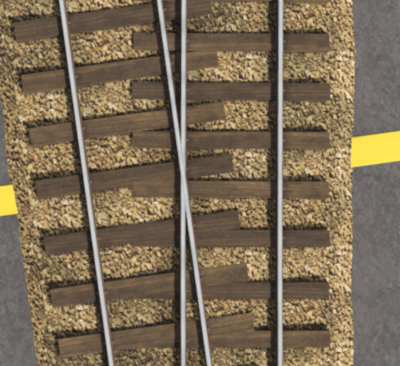 |
Identifying Procedural Track
There is no specific content category, such as "Track, procedural", that can be used to distinguish between procedural and non-procedural track assets. Like many assets it relies on the name given to the asset by the content creator. Most creators seem to have included the characters PRO in the track name - for example "Protrack", "Procedural" or just "Pro". This can be used to narrow down the search in CM. A typical CM custom filter that would be most likely to identify procedural track assets is shown below.

Laying Procedural Track
| The "fall-back" position for procedural track is to act and look like ordinary (non-procedural) track |
Procedural tracks are laid down in Surveyor just like any other track. Track junctions are formed in the same way as they are when using non-procedural tracks. The difference is that the additional features (animated switch blades, frogs and check rails) are automatically added when a track junction is correctly formed using procedural tracks.
Faulty (incorrectly formed) procedural track junctions will work perfectly well as non-procedural junctions - they can be switched left and right, and trains will pass over them correctly. But the special features that they have will not appear.
| A red track spline circle in Surveyor Classic indicates that the procedural track junction is faulty |
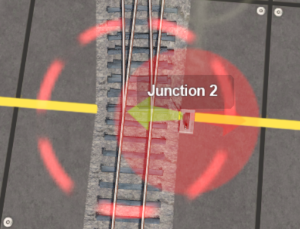 |
Faulty procedural track junctions are indicted in Surveyor by:-
|
| A red track spline "dot" in Surveyor 2.0 indicates that the procedural track junction is faulty |
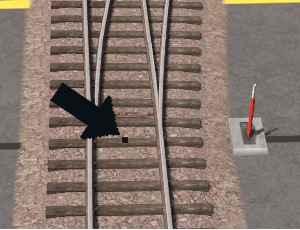 A normal procedural track junction in Surveyor 2.0 is shown as a black track spline point |
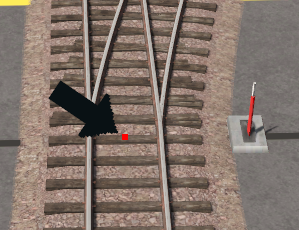 A faulty procedural track junction in Surveyor 2.0 is shown as a red track spline point. A better indicator is the absence of the moveable switch blade and the check rails/frogs. |
Procedural Track Errors
Some of the most common causes of red track splines are listed below. Remember, the presence of procedural track errors will not stop track junctions from working correctly as normal (non procedural) track junctions.
| Incompatible Tracks | ||||
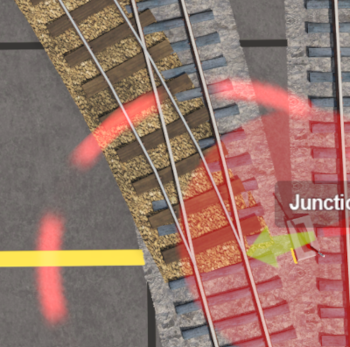 |
Fault:
One of the tracks used to form the junction is not a procedural track Solution:
|
|||
| Curve Too Tight | ||||
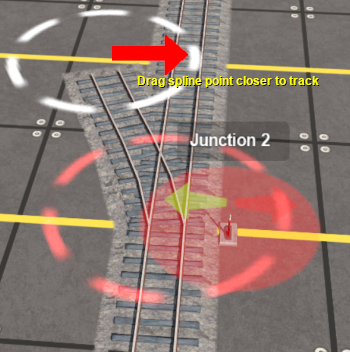 |
Fault:
One of the diverging tracks has a curve radius that is too tight Solution:
|
|||
| Track Splines Not Level | ||||
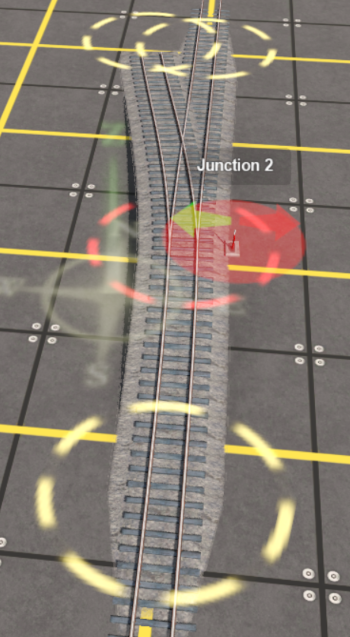 |
Fault:
The spline circles that define the junction are not at the same height Solution:
|
|||
| Junctions Too Close | ||||
 |
Fault:
A second junction has been added that is too close to the first and there is not enough room for the frogs/check rails to be added to the first junction Solution:
|
|||
Trainz Wiki
 |
More Tutorials and Guides to Using Trainz |
|
Related Content Creation Guides |
This page was created by Trainz user pware in June 2021 and was last updated as shown below.
